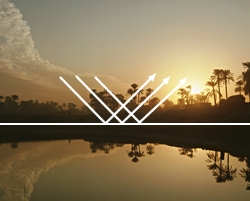The Law of Reflection
The law of reflection states that the angle of incidence is equal to the angle of reflection. Incidence is the arrival of a beam of light at a surface.

Reflection
Reflection occurs when light waves bounce off an object. One thing that reflects all around us is light. When you look in a mirror, you see light that has been reflected twice; it reflected from you first, then the mirror.
The Types of Reflection
Regular reflection is when light reflects off a smooth surface, for instance a mirror's surface is smooth.When light beams off all points of the mirror at the same angle, regular reflection occurs.
When light beams are reflected at the same angle, this type of reflection occurs. When our eyes see the reflected beams, we are able to see a reflection on the surface.
Diffuse reflection can occur when light is reflected off a slightly rough surface. A wall's surface is a little rough. When light beams will hit the wall's surface, it will reflect at many different angle. That's when diffuse reflection occurs.
When light beams reflect at many different angles this type of reflection occurs.our eyes do not detect a reflection because not all of the reflected light is directed toward our eyes.
How we use reflection in our daily lives?
Reflection of light is either specular (mirror-like) or diffuse (retaining the energy, but losing the image) depending on the nature of the interface. In specular reflection the phase of the reflected waves depends on the choice of the origin of coordinates, but the relative phase between s and p polarizations is fixed by the properties of the media and of the interface between them.
Ryann Cornelius



40/40 for this...Keep it up Ryann!!!
ReplyDelete